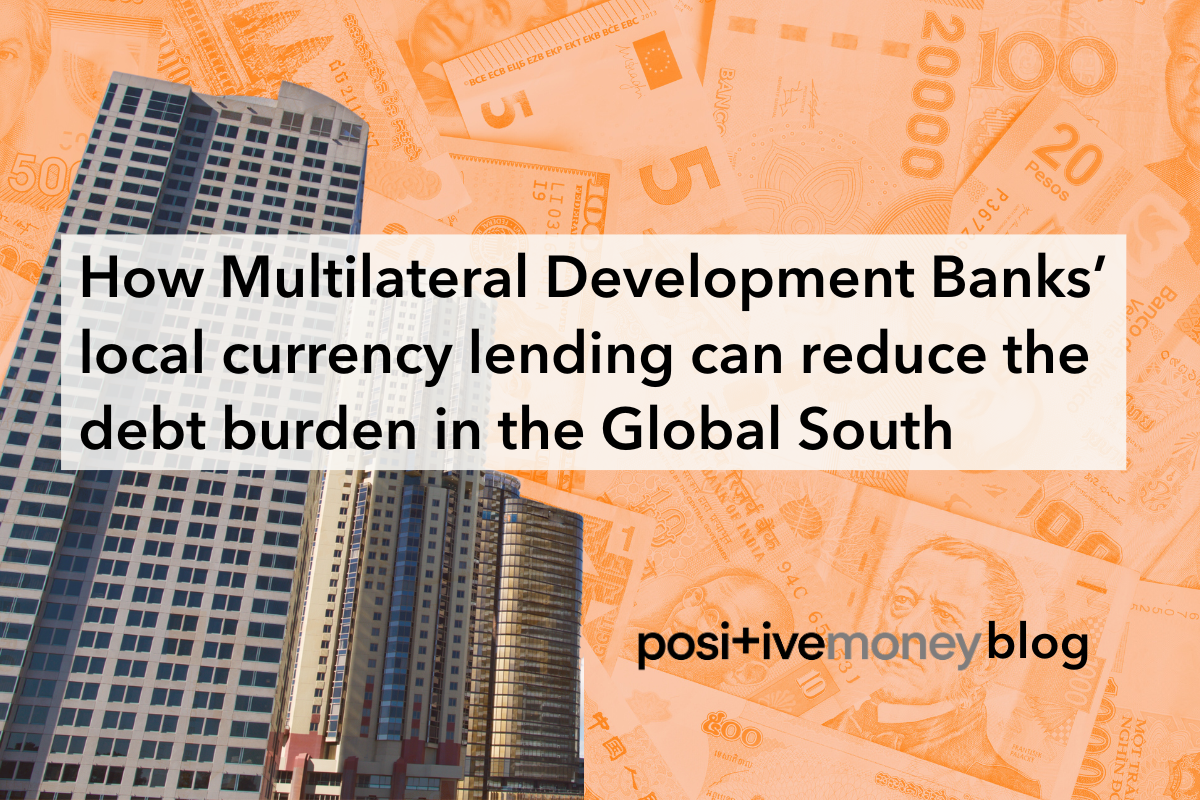
The future of moneyGlobal
2 December 2025
Boosting local currency lending by Multilateral Development Banks could reduce debt vulnerabilities in the Global South and provide greater fiscal space for sustainable development
With Global South countries' debt weighing heavily, and preventing spending on sustainable development or climate priorities, increasing lending in local currencies through Multilateral Development Banks could free up economic policy space and reduce dollar- and euro-denominated debt vulnerabilities.
The COVID-19 pandemic led to a surge in public debt levels worldwide, and subsequent monetary tightening in advanced economies increased debt servicing costs, particularly affecting countries from the Global South. According to the United Nations Trade and Development (UNCTAD), the number of countries with high debt increased from 22 in 2011 to 59 in 2023, and many now spend more on interest payments than on health, education, and investment. This financial burden limits these countries' ability to achieve the Sustainable Development Goals, which require $4.3 trillion annually, including $1.8 trillion for climate action.
The hierarchical structure of the International Monetary and Financial System (IMFS) presents additional challenges for developing economies, as nearly half of their public debt is denominated in international currencies from a few core economies, such as the US dollar and euro. During financial turmoil, these countries' local currencies depreciate, raising the cost of foreign currency debt and further constraining their capacity for developmental policies. Scaling up local currency financing is essential to bridge these countries’ investment gaps without worsening existing debt vulnerabilities. Multilateral Development Banks (MDBs) play a crucial role in this context.
In recent years, the G20 has urged MDBs to catalyse the development of local currency bond markets. Similarly, the United Nations, in their 2024 Financing for Sustainable Development Report, called for improvements to MDB lending terms, including local currency loans, to provide greater fiscal space for low- and middle-income countries (LMICs). How involved are MDBs in local currency financing and what are the barriers to increasing it? How can these barriers be addressed? In a recent report, we tried to answer these questions by investigating the current exposure and the potential for more local currency financing by MDBs to LMICs. We also explore why MDBs either choose not to lend in local currencies or face constraints when trying to do so. Finally, we enumerate some potential solutions to alleviate these restrictions.
Our research shows that MDBs predominantly lend in foreign currency, exposing LMICs to exchange rate risk and increasing debt vulnerabilities. Various factors explain this aversion; however, some may be overstressed. In this blog, we summarise our research and recommend measures to enhance MDBs’ capacity for local currency financing.
MDBs are supranational institutions aiming to foster economic and social progress in developing countries. They finance projects, support investment, and generate capital in these economies. These financial institutions prioritise developmental objectives over profit, often funding projects the private sector avoids due to perceived low short-term benefits and higher risks. Consequently, their focus is on long-term lending, emphasising developmental impact over financial risks. Additionally, MDBs provide external funding for developing economies, enabling countries to pay for imports and other cross-border transactions. Because of this, they are a vital source of funding for Global South countries excluded from international financial markets, being the principal holders of the external public debt of these economies.
The low acceptability of LMIC currencies among international lenders means that external debt in these economies is primarily denominated in US dollars or euros, increasing their debt vulnerabilities. When their exchange rate depreciates, local currency revenues of borrowers may decline, while the value of foreign currency debt service rises. This can make projects financially unsustainable and heighten the likelihood of debt crises. Ghana’s recent default on its external debt in 2022 exemplifies this vulnerability. Given the country’s heavy reliance on foreign currency borrowing, when the Ghanaian cedi depreciated sharply, servicing foreign currency debt became unmanageable, exposing the risks of external borrowing. Climate change further exacerbates this issue, as many climate-vulnerable countries depend on external financing for sustainability projects that generate revenue in local currency.
Because of this, local currency financing should be a core aspect of MDBs' developmental mandate. The advantages of local currency lending by MDBs extend beyond reducing vulnerabilities. Local currency lending can foster the development of LMICs' domestic financial markets, potentially diminishing reliance on external financing for local projects. Moreover, stable local currency lending by MDBs can help mitigate the negative effects often associated with private international borrowing. Even when LMICs manage to borrow in their own currency from private markets, this lending has been highly cyclical and influenced by global market developments.
Our research shows that besides the traditional indicators of stress in advanced economies' financial markets, such as the volatility index VIX, commodity price fluctuations significantly contribute to the large depreciations of developing economies’ currencies. Importantly, we find that the impact of these global shocks is more pronounced when non-bank financial investors have a notable presence in domestic bond markets. This analysis highlights the necessity for long-term local currency financing by MDBs, even in LMICs with relatively developed domestic markets.
Assessing the extent and nature of MDBs’ local currency lending is challenging due to a lack of detailed data on the currency composition of their portfolios. Using a mixed-methods approach based on semi-structured interviews and a survey with MDB representatives, we find that 81% of respondents believe their organisation should provide more local currency financing, while only 5% disagree. However, despite the clear desire among MDBs to provide more local currency lending, the actual level of local currency financing remains low. Our analysis of lending by MDBs shows that only 4% of these loans were denominated in borrowers’ local currencies, while 74.6% were denominated in US dollars and 19.2% in euros. Survey responses indicate a slightly higher, yet still low proportion of local currency financing, with the average of responses indicating that 14% of lending by MDBs is in local currencies. Consequently, most MDB lending has reinforced the dominance of major currencies, effectively rolling over the exchange rate risk on vulnerable borrowers.
Our results show that the reasons MDBs are reluctant to provide more local currency lending are due to risk management practices and statutory provisions concerning currency risk and how it is managed, which is further intensified by a lack of familiarity and expertise. When MDBs offer local currency loans, they rely on financial markets to hedge currency risk using instruments such as local currency bonds or derivatives. However, these strategies can be costly—particularly in LMICs, where high interest rates often exceed potential exchange rate depreciation risks. Consequently, most barriers are related to MDBs’ aversion to currency risk and the high costs of managing currency risk for Global South countries. More generally, this risk-aversion is grounded in their focus on capital protection and maintaining AAA credit ratings. But does local currency lending pose a significant risk to these?
Our research also suggests these fears might be overstressed. We find that sovereign local currency debt generally carries lower credit risk than foreign currency debt. By eliminating currency mismatches for domestic borrowers, local currency lending reduces default risk in the event of a depreciation. However, credit rating agencies often overlook this distinction, assigning similar risk profiles to both local and foreign currency debt, thus overestimating capital requirements for local currency lending. Moreover, our review of credit rating agencies’ methodologies for assessing MDBs shows that capital adequacy ratios currently place little emphasis on the currency denomination of MDBs’ lending. This indicates that, at least in the short term, increasing local currency lending would have minimal impact on credit ratings.
Finally, while partly unhedged local currency financing increases currency exposure, these positions typically generate profits in longer periods. Although they remain vulnerable to sharp depreciation during periods of global economic instability, MDBs—unlike private financial institutions—are better positioned to manage these risks, given their longer-term and stable liability funding structures.
Reforming MDBs' currency risk strategies is crucial for increasing local currency lending while sustaining their lending capacity. We propose different measures to better manage this: MDBs can better absorb potential losses by diversifying their portfolio exposure across multiple currencies, reducing reliance on costly external hedging mechanisms, and partially bearing some of the currency risks. To achieve this, they can develop their own currency risk models. This can be combined with an expansion of their hedging providers to include both LMICs' institutions and development organisations such as TCX, a non-profit organisation that provides hedging solutions for developing nations. This entity has demonstrated that effective LMICs' currency risk management is possible, obtaining a positive annual return of 1.6%. This could lower costs and reduce dependence on international private banks. Moreover, MDBs can reduce their currency mismatches by encouraging shareholder contributions in local currencies. Finally, the experience of initiatives like the ADB's Private Sector Window Local Currency Solution and the IDA-IFC-MIGA Private Sector Window Local Currency Facility shows how MDBs can manage and mitigate currency risks through innovative structures and external support.
In conclusion, reducing dependency on foreign currency debt is crucial for sustainable development, and MDBs can play a pivotal role by incorporating local currency lending as a core part of their mandate. This requires a shift in risk management strategies, allowing MDBs to assume a manageable level of currency risk in exchange for long-term economic stability in borrowing nations.
Iván Weigandi is a PhD candidate at Leeds University Business School, where his doctoral studies focus on the role of financial institutions in shaping global financial conditions.
Bruno Bonizzi is an associate professor of research at the University of Hertfordshire Business School. He holds a PhD in Economics from SOAS, University of London. His research focuses on macro-finance, with particular reference to emerging economies and institutional investors.
Annina Kaltenbrunner is a professor of global economics at the University of Leeds Business School. She holds a PhD in Development Economics from SOAS, University of London.
The authors are part of a group of researchers who have researched local currency lending by Multilateral Development Banks and written a report suggesting policies for overcoming barriers to increasing local currency financing for sustainable development.
__
Sign-up to our mailing list for regular updates, or donate to support our work to redesign our economic system for social justice and a liveable planet.
